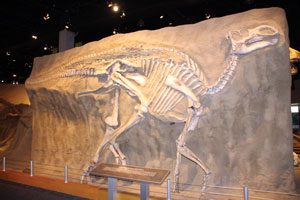
On Thursday, February 27, the Royal Tyrrell Museum Speaker Series travels back in time to the origin of the first animals.
Dr. Murray Gingras, professor in the Department of Earth and Atmospheric Sciences at the University of Alberta, will present a talk titled “585-million-year-old tracks reveal evidence of the first animals on Earth.”
For the first several billions of years of its history, the Earth was inhabited solely by microscopic, single-celled organisms, commonly called “bacteria.” Eventually some unicellular organisms began living in colonies and various cells began specializing to accomplish specific roles, resulting in the appearance of the first multicellular organisms roughly one billion years ago.
It is from this latter group that two groups of animals evolved: 1) radially symmetrical animals (i.e., animals with a top and a bottom, but no right or left, such as sea anemones and jelly fishes) and bilaterally symmetrical animals (i.e., animals with a right and left side, which include all animals from worms to humans).
However, the timing of the origin of bilaterally symmetrical animals (technically called bilaterians) is somewhat controversial. The oldest fossils and burrows left by bilaterians are found in deposits that are 555-million-years old, but recent analyses based on rates of DNA mutations suggest that this group of animals evolved much earlier, sometime between 580 million years ago to 1.1 billion years ago.
In his talk, Gingras will discuss his ongoing research on ancient marine deposits from Uruguay where he has discovered traces of fossils left by the most ancient bilaterian animals known to date. Speaker Series talks are free and are held on Thursdays at 11:00 a.m. until April 24, 2014 in the Museum auditorium. Each talk is approximately one hour long. Visit www.tyrrellmuseum.com for the most up-to-date schedule.
Speaker Series talks are also online on the Royal Tyrrell Museum channel on YouTube: http://youtube.com/user/RoyalTyrrellMuseum.





























